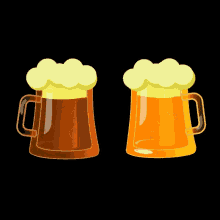
A lot of beer’s flavor depends on how it’s handled before it’s in your hand, too, from the brewery to the truck to the retail shop or barroom. For example, if it’s stored in warehouse for weeks at warm temperatures, that’s not ideal.
Once you’re ready to store or pour, following these simple guidelines can help you get the best possible sip.
American Lagers / Light Lagers
Go cold — anywhere in the 33- to 40-degree range is suitable for macro lagers. This is around your average refrigerator temperature, with 33 degrees, near freezing, on the low end. Your sweet spot is really between 36 and 38 degrees, which is the temperature of most draft beer systems.
Pale Lagers / Pilsners
For most lagers and pilsners, 38 degrees is ideally your low point. Anywhere up to the low-to-mid 40s is fair game. Pilsners are more traditionally served at 38 degrees, and are probably best suited there.
But for really hoppy American styles or IPLs [India Pale Lagers], the same holds true for those [as for NEIPAs] — you definitely get more expression with the hops as the beer warms up.
Amber / Marzen / Oktoberfest Lagers
For darker lagers, like Vienna-style, Oktoberfest or Marzen-style lagers, and amber lagers, you’ll want to go slightly warmer, in the 45 to 50 range. Stronger lagers, like a dunkel or doppelbock, would do well at 50.
Blonde Ale / Cream Ale
Due to their light body, mouthfeel, and grain bill, blonde ales and cream ales are best enjoyed in that pilsner range of 40 to 45.
Pale Ale
Pale ale is the style where things tend to get more flavorful, with fruity, citrusy notes playing a major role in hop character, bitterness and body reaching medium levels, and bolder malt choices, like caramel malt, starting to make appearances. An American pale ale is best imbibed at least 45 degrees, topping out as high as 50 degrees. An English-style pale ale, however, can be pushed to 50 to 55 degrees. This is because English-style pale ales, or extra special bitter (ESB)-style ales, are richer in flavor, fuller in body, and fruitier, thanks to yeast choices.
India Pale Ale
IPAs have such a variable range of flavors and sub-styles, trying to pin down one temperature is futile. Generally, you want the temperature to be higher than refrigerator temperature, which, as we said, is about 38 degrees. This allows all those tropical, citrusy, piney, dank, and herbal flavor and aroma compounds to show up to the party. The American IPA molecule party tends to get pretty turned up at about 50 degrees. Depending on the beer’s balance, alcohol level, and hop composition, it could rage at as low as 45 degrees and as high as 55.
Stout / Black Ale / Porter
This roasty trio really begs for a range, usually between 45 and 55 degrees.
Start with a stout at 44 degrees and allow it to warm up, similar to a New England IPA.
Nitro stouts do better on the lower end, 45 degrees being about as high as you’ll want to go for these uniquely gassed brews. For a typical American stout, those coffee and chocolate notes will really express at 50 degrees.
A milk stout could even go a little higher, as could a brown ale or English-style mild.
Imperial stouts, especially the big, ingredient-packed imperial dessert stouts of today, will also benefit from warmer temperatures, Bachli adds. 50 to 55 degrees is a good range for those beers. They’re very expressive and robust in flavor. Any time you cool a beer like that down too much, you miss out on a lot of flavor elements.
Wheat Beers
Wheat beers come in many forms: American wheat ale; Belgian-style wit; Berliner-style Weisse, and perhaps the best known, the Hefeweizen.
For the most part, these cloudy, yeasty brews are best served between 40 and 45 degrees. For the Hefe, which goes lighter on hop flavor and heavier on yeast-driven banana and clove aromas, slightly warmer temperatures are acceptable. Keep in mind, though, that you’ll be wrapping your hands around that big, vase-like glass, which will add heat.
Sour Beers
Sour, tart, and funky ales come in many forms — in fact, they are near infinite by nature — and so, too, can their ideal serving temps vary.
Anywhere from 45 – 55 degrees.
Since American sours tend to be high in acidity, a lower temperature might do well to minimize that lactic or acetic burn. For lambics and other fruited sours — Cassis, Framboise, Kriek, Peche —flavors can be sweet or dry, lightly or intensely acidic, pungent or subtle. In general, you’re safe in that 45- to 50-degree range.
Where Gose is concerned, try right above refrigerator temperature, in the low 40s, where aromas and flavors come out to play while the salty, tart notes stay thirst-quenching and refreshing. But watch out…., acidity intensifies as the temperature starts to rise.
Belgian Dubbels, Tripels, and Quads
Generally, the bigger and boozier the beer, the warmer the temperature can go, but this is not necessarily true. Belgian-style Dubbels are malt- and yeast-forward, often chocolatey and sweet, with fruity, banana-like esters.
Both Dubbels and Quadrupels are ideally served in the low- to mid-50s.
The Tripel, however, is tricky. Paler in color, lighter in body, and spicier in yeast character, Tripels are often drier and have a higher ABV (7 to 10 percent).
But, because they are bottle-conditioned and more similar in style to a golden ale, they tend to do better at lower temperatures, between 40 and 45 degrees.








